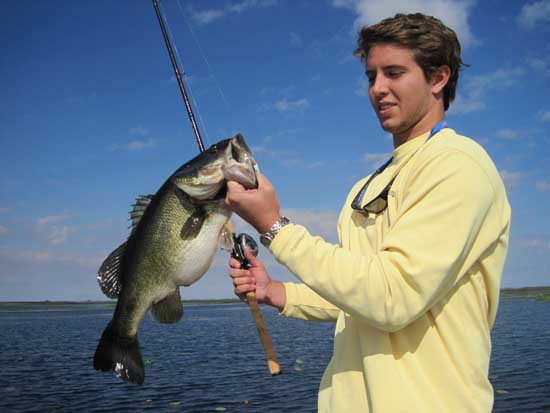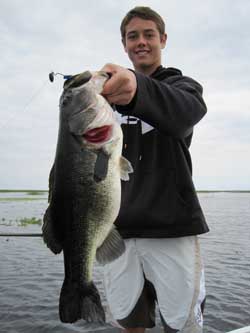When I was younger, single and had no kids, pre-fishing for tournaments was a part of my routine. I planned my pre-season time around sports shows and in-store promotions so I could scout any upcoming lakes on the B.A.S.S. schedule. In most cases, that additional effort paid off.
Unfortunately, over time, other obligations took away those opportunities — family mostly, and for that I have no regrets. I have two great sons, both of whom are athletes and honor students. But now that one is in college and the other soon to follow, I’m getting back some of that free time. So during the Christmas holidays, I decided to blend two opportunities into one — spending some quality time with my two sons while scouting Lake Okeechobee for the approaching Elite Series event.
Where To Start?
Lake Okeechobee is massive; with 730 square miles of surface area, it’s the largest natural lake in the Southeast. What’s more overwhelming is the fact that it’s shallow and covered in grass. Choosing a starting point can be daunting. Everything looks the same, especially to the untrained eye. It took me years to figure out a reliable process for eliminating water there.
Because the “Big O” is constantly changing, I wanted to spend as much time there as possible before the off limits went into effect (Bassmaster Elite Series rules impose a 30-day off limits prior to each event). With our family already in South Florida for the holidays, the timing couldn’t have been more perfect. My only concern was seeing enough of the lake while trying to keep my sons happy. Anytime you’re fishing with kids (even older teens), there has to be some reward for them. And knowing how different my two sons are — one with patience, the other with none — I knew that would be a challenge, especially dealing with inclement weather.
Oddly, though, the weather worked in my favor.
The first afternoon we arrived on the south end, accessing the Rim Canal near an area called Bay Bottom. Lake Okeechobee is unique in the fact that the entire lake is surrounded by a large dike. Alongside the dike is the waterway referred to as the Rim Canal, or Rim Ditch. Deeper on average than the lake itself, the Rim Canal offers safe navigation during foul weather or extreme low water periods. It’s also a great place to find bass, particularly when the lake is down.

Just as we got the boat in the water, a strong rainstorm hit us from the south. Choosing that access put us in the most protected part of the lake. Our timing couldn’t have been better either. The storm must have turned the bass on, as we quickly located an area where they were feeding aggressively. We caught numbers of bass on a variety of lures, including lipless crankbaits, topwaters, and swimming worms. The boys were pumped and having fun.
Once the sun hit the horizon, mosquitoes swarmed our boat. So we headed for Roland Martin’s Marina to set up base camp.
Overnight a cold front pounded South Florida. We woke to frigid northwest winds gusting to 25mph. I told the boys we were fishing in the upper-western part of the lake. We started in the Monkey Box area, so named for a strange beacon that was once housed inside a wooden box at the top of an old marker pole. At a distance, it looked like a monkey’s head inside a box. Years of bombardment from storms finally destroyed the marker, but the name lives on, and the Monkey Box is a fantastic place to fish.
I set one son up with a Senko on a spinning outfit, the other with a flipping rig. As we progressed along the kicker trail, I alternated between a topwater and a flipping craw. (Yes, topwater plugs can work well on Okeechobee, even after a cold front, so long as you fish them with patience).
The Monkey Box is a unique area — sort of a lake within a lake. With perimeter reed lines and scattered fields of grass, the protected bay can handle strong winds and remain totally fishable. Its open water grass beds feature all types of greenery, including hydrilla, eel grass, peppergrass, coontail moss and acres and acres of floating plants like hyacinths, hydro caudal and water lettuce. It a regular salad bowl flooded to the rim, and bass thrive there.
Early on I caught a 7 pounder under a mat, and that’s all it took to motivate both boys. You would have thought they were in a tournament the way they fished the rest of the day. By sunset, everyone had scored on quality fish, and the boys couldn’t wait to upload their images to Facebook.
Continuing The Search
The last day I opted to fish the north end where the Kissimmee River enters the lake. Besides the river mouth, there are other sweet spots, like King’s Bar, Tin House Cove, Eagle Bay and J&S — all known for producing great tournament catches over the years. Besides that, the north end was on the way home. I knew we could fish till dark and still make it back to north Florida at a decent hour.
Like the day prior, I started by alternating between a topwater and a flipping rig. My youngest son, Trevor assumed his casting routine, targeting isolated clumps of arrowheads and round reeds. My older boy, Daniel, flipped steadily behind me. The front made fishing tougher, but we eventually managed some numbers. More importantly, it gave me a chance to see how things had changed since the recent influx of rainwater.
Back in the summer, the lake was desperately low, but thanks to heavy rains through the fall months, the Big O is back up to nearly 14 feet above sea level — the perfect height for bringing bass to the grass.
That night we ate dinner with my longtime friend and Okeechobee mentor, Steve Porter. Together we teased the boys about the “good ol’ days”, and how easy it was to catch fish back then. The truth is, for the most part, it’s still pretty easy. What’s difficult is finding the right fish — the winning fish.
After three days of scouting the lake with my two sons, I know in many ways I’ve already won.





